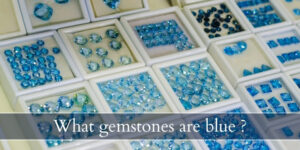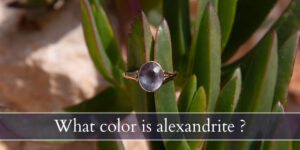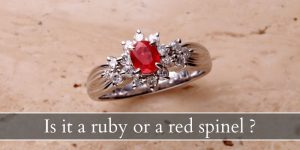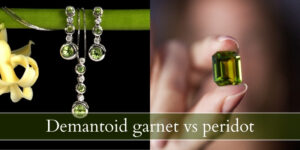Elongated diamonds shapes can really make your fingers look slim and slender, but what do you do when there are two such cuts ? How do you choose between an emerald cut diamond and an oval cut one ? How do they look in engagement rings ? Which one sparkles the most ? Which one goes better with a vintage setting ? Let’s discuss ovals vs emerald cuts !
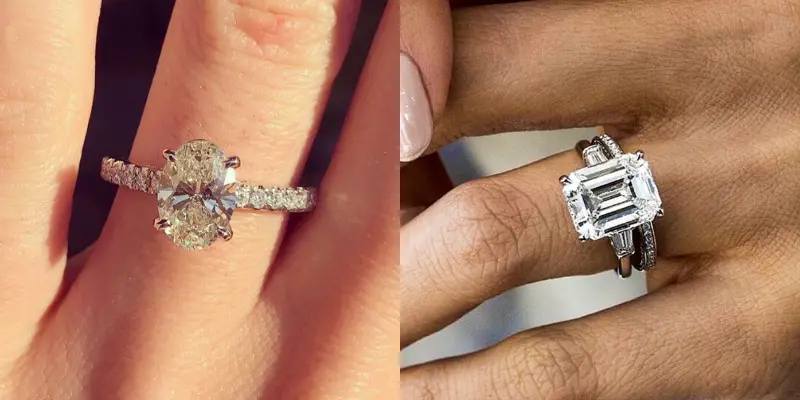
Oval vs emerald cut diamond
Oval cut diamonds sparkle much more and emerald cuts, and are also more popular. Oval cuts are a brilliant cut, but they tend to hold onto color at their tips but still hide inclusions well enough, while emerald cuts show both inclusions and color immediately. Emerald cuts are usually better cut than ovals, so you will usually get a better quality emerald cut than an oval diamond.
Overall it seems that oval cuts are the second most popular after round brilliants, and you will have an easy time finding the right oval for you. Emerald cuts are more of an elegant, subdued look and may not be for everyone. Always check diamonds in person though, regardless of the cut and style.
What is an oval cut ?
Oval cut diamonds are a type of brilliant cut, in the shape of an oval. When face up the oval cut looks like an elongated round cut, with the ends tapered. These cuts are very popular and seem to inspire nostalgia, reminding some of vintage rings their aunts or grandmothers used to wear.
Oval cuts are beautiful and elegant, but like other elongated brilliants they may show a bowtie. The bowtie is a set of facets right in the middle of the pavilion, where the facets are wider than the rest, and this can sometimes result in a darker or duller area, in the shape of a bowtie. All ovals feature a bowtie, but not all of them look bad. Some are very dark, while others are just slightly duller than the rest of the diamond.
As a brilliant cut the oval can hide a bit of inclusion, so clarity isn’t the biggest issue. But color grade is an issue, since ovals will concentrate the color towards the tips, where the diamonds gets thinner and there are less facets.
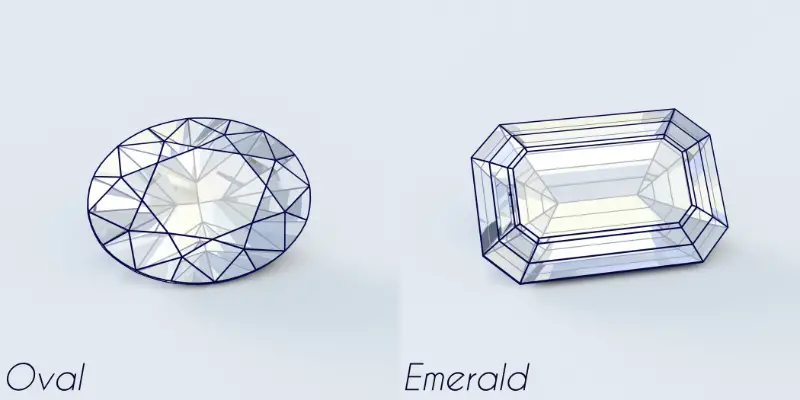
What is an emerald cut ?
Emerald cut diamonds are a type of step cut, meaning they have fewer facets than a brilliant are they are arranged differently. Emerald cuts are elongates rectangular shapes with clipped corners. Their facets run parallel to each other, forming a sort of staircase effects, leading down into the middle of the diamond. The overall look of an emerald cut is highly geometric, and very well suited for Art Deco styles.
Emerald cuts are very elegant and offer a mode subdued look than brilliant cuts. These cuts elongate the finger and have a more subdued sparkle.
This diamond cut got its name from first being applied to actual emerald gemstones. Emeralds are prone to breakage is not cut properly, so the emerald cut was designed to follow along an emerald’s natural grain or growth direction, which in turn made the emerald sturdier. Nowadays this style of cut can be applied to any gemstone at all.
Read also: Pear Cut Diamond Guide (Cut, Clarity, Color, Prices)
Oval cuts sparkle much more than emerald cuts
An oval cut diamond will sparkle much more than an emerald cut, since it has many more facets. Generally the more facets a diamond has, the more sparkle it has, or rather the smaller the shards of light. The alignment of the facets is also crucial, since diamonds are essentially mirrors turned inwards. So an oval cut diamond is a set of dozens of tiny, tiny mirrors, each reflecting and refracting and bouncing the light, until it finally exits through the table.
The emerald cut has far fewer facets, but that is not all. The facets are long and thin, but overall each facet in an emerald cut is larger than the ones in an oval cut, leading to less sparkle. The emerald cut’s facets are directly opposite each other, and are not at an angle from each other, so the effect is more like a set of glass stairs leading down into the middle of the diamond.
Emerald cuts do sparkle, but far less than oval cuts. They have more sparkle around their shoulders, where the facets are simply smaller due to the way the pavilion is arranged. Other facets will offer flashes of white or rainbow light, instead of tiny sparkles.
Emerald cuts have better cut quality than ovals
When you’re buying a diamond you’re looking at several factors, like color and carat weight and culet and so on. One of the most important for a diamond’s light return, sparkle, light leakage, and overall charm is its cut quality. If the diamond isn’t very well or perfectly cut, you will lose sparkle, you will get a very dark or overly bright diamond, and generally be disappointed with your money spent.
With round brilliants, there is a ridiculous competition and many jewelers and retailers offer the best, because these are the most sought-after style. But ovals aren’t as popular as rounds, so the cut quality is a bit lax. You have a high chance if finding poorly cut ovals, since there aren’t as many people falling over themselves to buy one.
The amount of work needed to align the facets on an elongated brilliant cut is also no joke. Few lapidaries can do this properly, which is why you’ll sometimes find misaligned ovals, marquises, and pears. This is one of the factors that directly influences how bad a bowtie will be, by the way.
Emerald cuts are not as popular as oval cuts, but they get a better cut quality on average. Why ? Because they are a much simpler cut, much easier to align the facets properly, and you can clearly see into the diamond to figure out any mistakes you’ve made and correct them (if needed). There is also more mental pressure when it comes to emerald cuts, since these cuts always show any issues that the diamond may have. So the lapidary may be inclined to pay extra attention to the overall quality of the cut for this style.
Emerald cuts require a higher clarity diamond
So ovals don’t always get a high quality cut, but when they do they can hide a bit of a clarity issue if need be. This is because oval diamonds are brilliants, and they may hide a bit of inclusion within their many, tiny facets. Emerald cuts are open mirrors and they will show you the color and inclusions immediately.
If you’re buying emerald cuts, you shouldn’t go lower than VVS2, since this cut won’t do you any favors. If there are inclusions, they will be noticeable. VVS2 is the last safe grade, since any inclusion won’t be easily noticed with the unaided eye. Ovals can go as low as VS1, but pay close attention where the inclusions are within the diamond. Make sure they aren’t near the oval’s tips.

Be mindful of oval cuts, since they can concentrate color towards the tips where there are less facets and they are shallower. Emerald cuts will also show you the exact color of the diamond, but they will not concentrate the color in a specific spot within the diamond.
Both emerald and oval cuts elongate the finger
Something ovals and emeralds do very well, or perhaps just as well, is elongate the finger. It’s an age-old trick, making the fingers and the hand look more slander by wearing a gem that’s longer than it is wide. It draws the eye and makes it assume that the finger is also a slim and long, like the diamond.
The only real difference between an emerald and an oval cut in this regard is their sparkle. Both elongate the finger but the emerald has a much more subdued and understated lightshow, which some may consider more elegant than the dazzling oval. Really this is up to personal preference.
Emerald cuts and ovals can also be set east west and look very good, if you want something that’s a little different form the rest. An east west setting can make the diamond appear a bit larger than it actually is, since it looks like it takes up more space on the finger. An east west oval may take up the entire width of the base of your finger, but if you turn it north south (classic) it may look smaller.

I’m the main author for jewelrymaterialguide.com. I started this site after we did tons of research before our wedding and noticed that there is information about rings, jewelry, and so on that is really hard to find on the internet.


